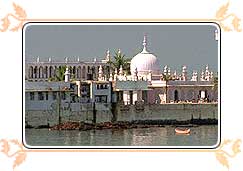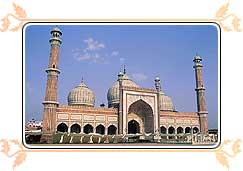
The Muslims are about 12% of India's population. But their influence on the Indian society was much stronger. The main reason was that there were many Muslims rulers in different parts of India. Most of the Muslim rulers of India were invaders from the west (see India in the past ).

Islam was established in Saudi Arabia. But most of Islam's spreaders in India arrived from non-Arab countries. The first spreaders of Islam in India were individuals who saw in spreading Islam as a holy precept. They began coming to India from the 11th century. They arrived in India from Bukhara, Turkey, Iran, Yemen and Afghanistan. The most famous preacher of Islam in India was Khwaja Chishti, who arrived from Iran and his sect is called Sufism. But the accepted assumption in India is that most of India's Muslims were converted to Islam through the sword. Meaning the Indians were given an option between death or adopting Islam. The third option was getting examined in Islam religion along with heavy taxes- Jeziya (poll tax) and Kharaj (property tax).
The process of converting Indians to Islam began in the 8th century, when the Arabs began invading north India and present day Pakistan. After the Arabs other Muslims invaded India. These invasions by Muslims in India were not continuous and not all Muslim invaders were Islamic fanatics. One of the Moghul emperors, Akbar, was very liberal and he even established a new religion, Din E Elahi, which included in it, beliefs from different religions. In some of the monuments built by Akbar symbols of different religions are visible. In contrast with Akbar his great grand son, Aurangazeb, was a fanatic Muslim and during his term the non-Muslims suffered a lot. Many worshipping sites of different religions were destroyed and transformed into mosques.
Most of the Indian Muslims converted to Islam were belonged to the lower classes of the Indian society. Besides these Muslims there are also Muslims who belonged to the ruling families of the different Indian kingdoms. Some of these rulers were Hindus who actually belonged to the warrior castes of the Hindu society and adopted Islam.
Others are descendants of Muslim rulers who invaded India. The different Muslim rulers of India also brought to their kingdoms Muslim mercenaries, businessmen and slaves from different parts of the world like Russia; Afghanistan; Turkey; Arab countries and Africa. These people remained in India, married local Indians and converted them to Islam. Because of the different origins as stated and because of other reasons the Muslims of India refer to themselves not only as Muslims but also with other titles.

In general the Muslims of India like the Muslim world is divided into two main sects, Sunni and Shia. And just like in the whole Muslim world there is tension between these two sects. Each sect has many different schools. There are also Muslims who claim to be the descendants from the daughter of Prophet Muhammad and the men in this community add the title Syed before their names. Other claim to be the descendants from the first Muslims and add the title Sheik. Along with these Muslim world divisions, the Indian Muslims also have other divisions.
Different communities who adopted Islam in different ways have different community names. In west India the Bohra and Khoja are Muslim communities who adopted Islam influenced by different Muslim preachers. The Khojas also split into different communities. The leader of the Khoja (Nizari) community is Aga Khan. The Nawait are descendants of Arab and Persian immigrants. In south India in the state of Kerala, the Mophilla community is descendants from Arab merchants. A well known Indian Muslim community is Pathan. The Pathan are Muslims who arrived from Afghanistan.
They normally have their surname as Khan. The Pathan have an image of being brave, honest and righteous. Many Indians who adopted Islam adopted the surname Khan and they claim that they are Pathans, which is not always true. The original Pathans claim that they originate from the Tribes of Israel.
In the beginning of the 20th century, some reformist Muslims organizations evolved in India who wanted to adjust Islamic philosophy to the modern world. These organizations wanted to cancel polygamy and were in favor of women education.
| BUDDHISM | CHRISTIANITY | HINDUISM | JAINISM | JUDAISM |